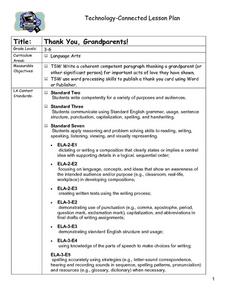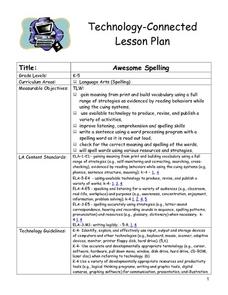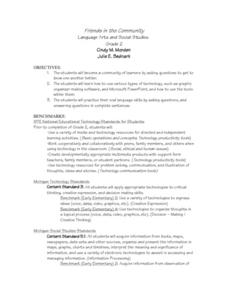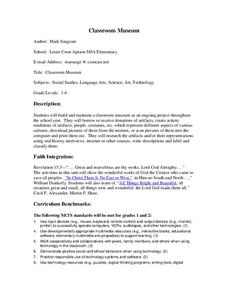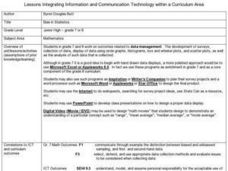Curated OER
Energy and the Environment
Fifth graders define alternative energy form, design models which show how the energy source can be used, and explain the purpose of dams.
Curated OER
Sound Box
Students make simple observations and identify relevant variables, such as frequency and diameter. They then discuss the relationship between variables. The task assesses students' abilities to make simple observations and make...
Curated OER
Identifying Elements
Students use diffraction glasses to find similarities and differences between observed spectrum of fluorescent light and an incandescent light They work in groups of 4-6 for the experiment/activity part of this exercise.
Curated OER
Dichotomous Key
Eighth graders use a dichotomous key to identify unknown fictitious organisms. They work individually during this exercise. The task is designed to take students approximately 15-25 minutes to complete.
Curated OER
Formation of Wind
Young scholars correctly sequence the steps leading to the formation of wind, and describe the cause and effect relationships involved in the formation of wind. This task assesses students' abilities to classify, generalize, infer,...
Curated OER
Cardinal Directions
Students discover cardinal directions through the use of digital cameras, compasses, and file folders in this technology-based lesson for early elementary students. Emphasis is placed on student practice and inquiry.
Curated OER
Author Study
Students work collaboratively to create PowerPoint presentations on an author of their choice. This lesson is written for a first and third grade joint project with students pairing up across grade levels.
Curated OER
Enhancing Literacy with Podcasting
Pupils write stories, print hard copies, and use the GarageBand program to add music and record the narrations. A handout to download, of instructions is included in this early-elementary lesson.
Curated OER
Human Body Parts
Students create body cutouts of themselves and label specific internal and external organs/parts that are covered in class in this exciting lesson on Human Anatomy. Digital cameras and pictures of various internal organs are required.
Curated OER
Teaching Rhythm and Pitch Reading
Middle schoolers practice correct rhythms and pitches during this short instructional activity for the middle school instrumental class. Objectives vary depending on music used for the instructional activity. Students assessed through...
Curated OER
Thank You, Grandparents!
Pupils share important moments with their grandparents. Individually, they write one paragraph thanking them for being in their lives or for a specific event they have been involved in. They also identify ways they act like their...
Curated OER
Awesome Spelling
Learners are introduced to spelling words as a whole class by viewing a PowerPoint. They spell the word, repeat and spell the word again as a whole class. Pupils create a sentence orally using the list of words. Students work in small...
Curated OER
Using "Why Mosquitoes Buzz in People's Ears" to Teach Cause and Effect
Students discuss cause and effect relationships and the chain reaction involved before listening to the story "Why Mosquitoes Buzz in People's Ears". Students create flow charts to show the chain reactions of causes and effects in the...
Curated OER
Friends in the Community
Second graders build a classroom community by getting to know each other better. They ask classmates various questions and use graphic organizer software and Microsoft PowerPoint. Students practice their oral language skills while asking...
Curated OER
Classroom Museum
Students investigate various aspects of culture. They collect artifacts from various resources as an ongoing project throughout the school year. Students reflect upon the differences in cultures and subject areas as they conduct research...
Curated OER
Hunger/ Nutrition
Seventh graders investigate nutrients and nutrition to determine what types of food the body needs for energy. They study each type of nutrient and why it is important to the body. They determine what a balanced diet is by completing the...
Curated OER
Bias in Statistics
Students work to develop surveys and collect data. They display the data using circle graphs, histograms, box and whisker plots, and scatter plots. Students use multimedia tools to develop a visual presentation to display their data.
Curated OER
Map Reading
After examining a map from 1803 and 2003, they explore how to become map readers. They describe what they see on the map from 1803 and compare the information to the map from 2003. Learners create their own map of the neighborhood that...
Curated OER
Aruba Cloud Cover Measured by Satellite
Students analyze cloud cover and to compose written conclusions to a given related scenario. They submit a letter of response and a report detailing their calculations and conclusions.
Curated OER
The Cycle of Life
Eighth graders search for rites of passage in their own lives and study rites of other cultural groups in Louisiana and around the world. They assess how to recognize moments of importance in people's lives and find meaning in the stages...
Curated OER
Making $ents
Second graders complete several activities that give them opportunities to practice and model strategies that help them count money. They read The Penny Pot storybook; they play a trading game with various coins. They participate in a...
Curated OER
Fly, Fly Away
Students use materials from their own environment to design a kite. In this kite design lesson, students research the history of kites and obtain a formal mathematical definition of a kite. Students sketch kite designs after discovering...
Curated OER
The Water Cycle
Second graders use the program HyperStudio to draw and describe the water cycle. In this science and technology lesson, 2nd graders will first become familiar with the water cycle by exploring books and websites in the classroom. Next,...












